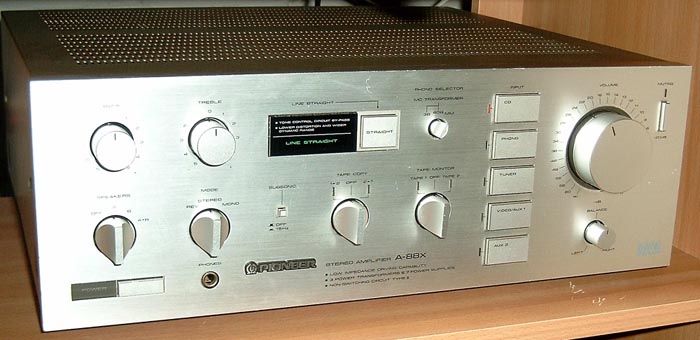Pioneer A-88X
Data
General
- Manufacturer: Pioneer
- Model: A-88 X
- Type: Integrated amplifier
- Years of manufacture: 1985 - 1986
- Color: Silver or black
- Remote control: no
- Power consumption:
- Dimensions: 420 x 155 x 427 mm (WxHxD), width with wooden side panels 457 mm.
- Weight: approx. 18 kg
- Original price approx.: 1'700 DM
Connections
- Number of inputs: 7 (Cinch)
- Phono (MM/MC switchable, MC with adjustment)
CD
- Tuner
Aux 1
- Aux 2
- Tape 1
- Tape 2
- Number of outputs: 2 (Cinch)
- Tape, Rec 1
- Tape, Rec 2
Technical Data
- Continuous power at 8/4 Ω
120 W at 8 Ω (RMS 20-20 kHz, at 0.003 % harmonic distortion)
- Dynamic power at 8/4/2 Ω: 169/300/441 watts.
- Total harmonic distortion: 0.003 %.
- Cross distortion: 0.003 % (50 Hz:7 kHz at 4:1, at active power).
- Power bandwidth: n. A.
- Attenuation factor: 100 (20-20 kHz, 8 Ω).
- Input (Sensitivity/Impedance).
- Phono MM: 2.5 mV/50 kΩ, MC: 0.25 mV/100 Ω.
- Line inputs: 150 mV at 30 kΩ
- Output (level/impedance): 150 mV/2.2 kΩ
- Frequency response.
- Phono: 20-20 kHz ± 0.2 dB
- Line: 10-100 kHz + 0-3 dB
- Tone control
- Bass: ± 8 dB at 100 Hz
treble: ± 8 dB at 10 kHz
- Loudness: no
- Subsonic filter: yes, 15 Hz, - 6 dB/octave
- Mute: yes, - 20 dB
- Direct/"Line Straight": yes
- Ripple distance (short-circuited)
- Phono MM/MC: 89/76 dB (40 Ω), 76 dB (3 Ω)
Line: 110 dB
Special Features
- Stereo to mono
- Stereo reverse (swap channels)
- Separate power supplies for one power amplifier and the preamplifier each, double mono construction
- Gold-plated phono input
- Separate speaker relays for each channel, electronically switched
Notes
- Previous model:
- Pioneer A-80
- Successor model:
- Pioneer A-858
Other models in the same series
- [[Tuner:
- Pioneer F-99 X
- CD player:
- Pioneer PD-9010 X
- Tape Deck:
- Pioneer CT-A 7 X
- Pioneer CT-A 9 X
- Turntable:
- Pioneer PL-90
- Speakers:
- Pioneer DSS-E 6
- Pioneer DSS-E 10
Pictures
- Image: Pioneer A-88 X
- Excerpt from brochure: Pioneer A-88 X
Reviews
- The A-77X and A-88X models were Pioneer's Elite series amplifiers at the time, with the A-88X leading the series in terms of features and also performance. The units probably evolved from their predecessors, the A-60 through A-80, which had fairly similar specs.
- All models (starting with the A-66X) have "of course" metal fronts and controls. The volume control of the A-88X is completely made of metal and is attached to the potentiometer with an Allen screw.
The A-88X is a typical fat Japanese amp: solid workmanship, full output power and connections with impeccable technical data.
- At the time, this model was Pioneer's top of the line. But just as typically Japanese: in Japan itself there was still a number larger.

